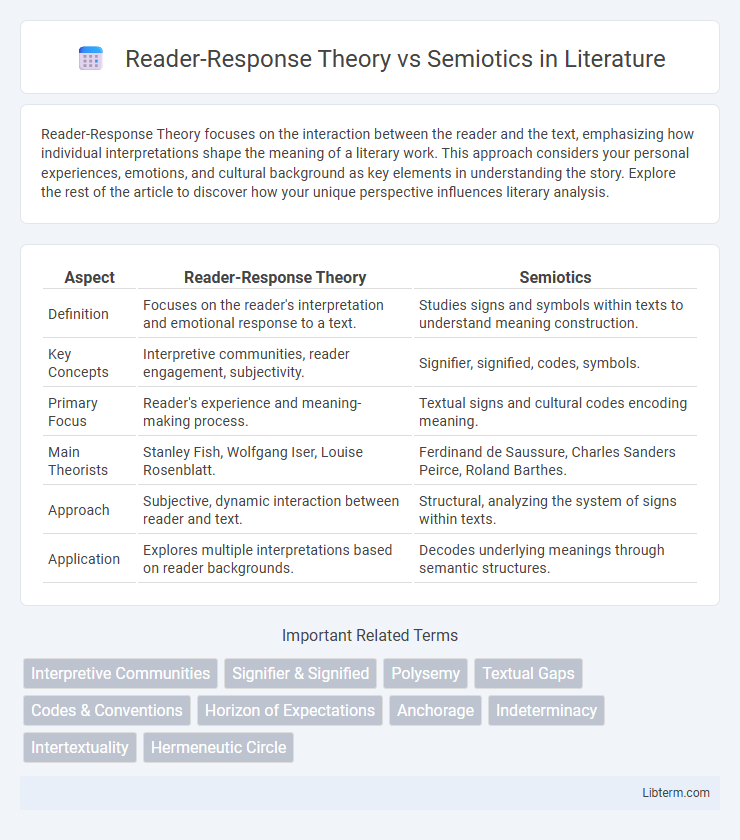Reader-Response Theory focuses on the interaction between the reader and the text, emphasizing how individual interpretations shape the meaning of a literary work. This approach considers your personal experiences, emotions, and cultural background as key elements in understanding the story. Explore the rest of the article to discover how your unique perspective influences literary analysis.
Table of Comparison
| Aspect | Reader-Response Theory | Semiotics |
|---|---|---|
| Definition | Focuses on the reader's interpretation and emotional response to a text. | Studies signs and symbols within texts to understand meaning construction. |
| Key Concepts | Interpretive communities, reader engagement, subjectivity. | Signifier, signified, codes, symbols. |
| Primary Focus | Reader's experience and meaning-making process. | Textual signs and cultural codes encoding meaning. |
| Main Theorists | Stanley Fish, Wolfgang Iser, Louise Rosenblatt. | Ferdinand de Saussure, Charles Sanders Peirce, Roland Barthes. |
| Approach | Subjective, dynamic interaction between reader and text. | Structural, analyzing the system of signs within texts. |
| Application | Explores multiple interpretations based on reader backgrounds. | Decodes underlying meanings through semantic structures. |
Introduction to Reader-Response Theory and Semiotics
Reader-Response Theory emphasizes the active role of the reader in creating meaning, highlighting how individual interpretations shape a text's significance beyond the author's intent. Semiotics studies the signs and symbols within language and texts, focusing on how meaning is constructed through systems of signs rather than individual perception. Together, these frameworks explore meaning from complementary perspectives: Reader-Response centers on subjective engagement, while Semiotics analyzes the structural elements that guide interpretation.
Historical Origins of Reader-Response Theory
Reader-Response Theory emerged in the 1960s and 1970s as a reaction to formalist and structuralist approaches, emphasizing the reader's role in constructing textual meaning. Key figures such as Wolfgang Iser and Stanley Fish developed concepts highlighting the interpretive activity and subjective experience of readers. This theory contrasts with Semiotics, which, rooted in Ferdinand de Saussure and Charles Sanders Peirce's early 20th-century work, focuses on signs and systems of meaning within language and culture.
The Foundations of Semiotics in Literary Analysis
The Foundations of Semiotics in Literary Analysis emphasize the study of signs and symbols as essential units of meaning within texts, analyzing how language and imagery function to generate interpretations. Reader-Response Theory contrasts this by centering the reader's subjective experience and personal engagement, highlighting how meaning is co-created through individual interpretation. Semiotics provides a structured framework to decode textual sign systems while Reader-Response foregrounds the dynamic interaction between text and reader in producing literary significance.
Key Concepts in Reader-Response Theory
Reader-Response Theory centers on the active role of the reader in creating meaning, emphasizing individual interpretation and the reader's emotional engagement with the text. Key concepts include the "implied reader," the "interpretive community," and the dynamic interaction between reader and text that produces multiple meanings. This approach contrasts with Semiotics, which analyzes the structure of signs and symbols independently of individual reader interpretations.
Core Principles of Semiotic Theory
Semiotic theory centers on the study of signs and symbols as fundamental units of meaning, emphasizing the relationship between the signifier (form) and the signified (concept). It explores how meaning arises from the interaction between these elements within cultural and social contexts, highlighting the arbitrary nature of signs. Reader-Response Theory contrasts by focusing on the reader's interpretation and emotional engagement, but semiotics prioritizes the structural mechanisms underlying meaning creation in texts and media.
The Role of the Reader: Interpretation and Meaning
Reader-Response Theory emphasizes the active role of the reader in constructing meaning, suggesting that interpretation varies based on individual experiences, emotions, and cultural context. Semiotics, by contrast, analyzes the system of signs and symbols within a text, focusing on how meaning is generated through codes and conventions embedded by the author. The interplay between reader interpretation and semiotic structures highlights the dynamic process where meaning emerges both from textual elements and the reader's subjective engagement.
Sign Systems: Understanding Texts through Semiotics
Reader-Response Theory centers on individual interpretation, emphasizing readers' subjective experiences and emotional engagement with texts. In contrast, Semiotics explores sign systems by analyzing the relationship between signs, meanings, and cultural codes embedded within a text. Semiotics enables a deeper understanding of how texts communicate through symbols and signs, revealing underlying structures that shape meaning beyond personal interpretation.
Comparative Analysis: Reader Engagement vs. Signification
Reader-Response Theory emphasizes individual readers' interpretations and emotional engagement as central to textual meaning, highlighting subjective interaction with literature. Semiotics focuses on the systematic study of signs and symbols within texts, analyzing how meaning is constructed through signification processes governed by cultural codes. Comparing both, Reader-Response prioritizes personal meaning-making and active reader participation, while Semiotics centers on the structural mechanisms that produce and regulate textual meaning beyond individual interpretation.
Applications in Literary Criticism and Analysis
Reader-Response Theory emphasizes the reader's role in interpreting texts, highlighting individual perception and emotional engagement as central to literary analysis. Semiotics focuses on the study of signs and symbols within texts, decoding underlying meanings, cultural codes, and linguistic structures to uncover deeper significance. Both approaches are applied in literary criticism to explore how meaning is constructed either through the reader's experience or through the sign systems embedded in the text itself.
Conclusion: Integrating Reader-Response Theory and Semiotics
Integrating Reader-Response Theory and Semiotics offers a comprehensive framework that emphasizes the dynamic interaction between the reader's interpretive role and the sign systems within texts. This synthesis enriches literary analysis by acknowledging both the subjective experience of meaning-making and the structural codes governing textual production. Consequently, understanding literature through this combined lens facilitates deeper insights into how meaning is constructed, negotiated, and diversified across different cultural and contextual backgrounds.
Reader-Response Theory Infographic

 libterm.com
libterm.com